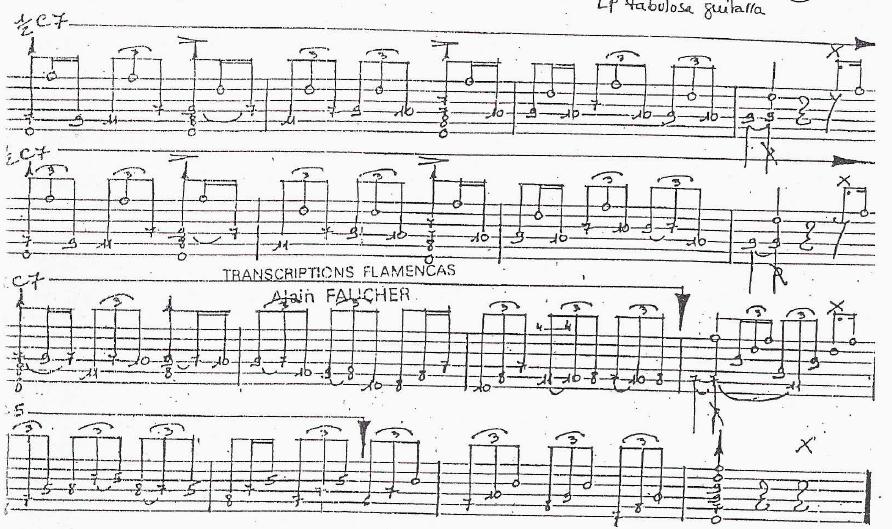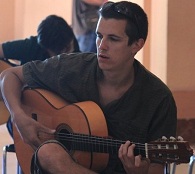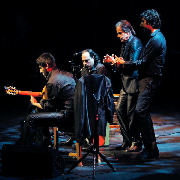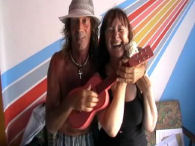Welcome to one of the most active flamenco sites on the Internet. Guests can read most posts but if you want to participate click here to register.
This site is dedicated to the memory of Paco de Lucía, Ron Mitchell, Guy Williams, Linda Elvira, Philip John Lee, Craig Eros, Ben Woods, David Serva and Tom Blackshear who went ahead of us.
We receive 12,200 visitors a month from 200 countries and 1.7 million page impressions a year. To advertise on this site please contact us.
|

|
|
Compas explanation
|
You are logged in as Guest
|
|
Users viewing this topic: none
|
|
Login  | |
|

   
Bogdan1980
Posts: 370
Joined: May 23 2007
From: Frederick, MD

|
 Compas explanation Compas explanation
|
|
|
So guys, I've been fighting with this for a while now. Can we all get into this an try to lay it out in the simplest terms!? I read that flamenco compas is complex, and I have this large document with compas analysis, but it's very unclear (I think I got it from this forum). I seem to be good with staying in the rhythm, so I learnt Barrio La Vina (alegrias), and it seems to sound right, but I don't really have an understanding of what's going on,.
How can I figure out the compas? Especially things like Bulerias and Soleares. I know it's a 12 count, and it goes something like 1-2-3 --1-2-3 --1-2- -1-2-- 1-2
But how do you apply this? Attached here is the image of PDL Solea, (beginning), how would you count through this?

Images are resized automatically to a maximum width of 800px
 Attachment (1) Attachment (1)
|
|
|
|
REPORT THIS POST AS INAPPROPRIATE |
Date Aug. 26 2007 20:32:43
 |
|

   
Ricardo
Posts: 14887
Joined: Dec. 14 2004
From: Washington DC

|
 RE: Compas explanation (in reply to Bogdan1980) RE: Compas explanation (in reply to Bogdan1980)
|
|
|
quote:
I seem to be good with staying in the rhythm, so I learnt Barrio La Vina (alegrias), and it seems to sound right, but I don't really have an understanding of what's going on,.
You seem to???? Then what is the problem? Sorry to also sound patronizing, but you have "learn't" Barrio la Viña but are not sure what is going on with the compas.
Trying to learn from the top down is the hard way. First you need to have a base of rhythm guitar, that being rasgueados. Once you can do that in compas, you start with some basic traditional type phrased falsetas, stuff like guitar accompanists use to accompany footwork. Once you have THAT then, these Paco FALSETAS (not the entire piece as if it is a sonata allegro) will be crystal clear interms of rhythmic phrasing.
I have a student that also learned RECUERDO A PATIÑO from Fabulosa. In anycase, he also knew nothing about the compas before his first lesson and even though he could make it sound sort of right, it was ALL WRONG because he did not feel the phrasing. So he learned quick the basics I described and then went back and applied what he learned to this piece and relearned SOME of it properly.
So after getting that off my chest, I will give you the info you ask for. Faucher represents the compas, the 12 count compas of Alegrias solea bulerias etc, as FOUR measures or bars of 3/4 time. Hopefully you understand triplets/eights etc, so the 12 counts are the quarter notes. He marks the Accents clearly with ACCENT MARKS in the score. These ">" are accent marks. Notice they occur in the first compas on count 3 of the first and second measures. The 3rd measure has no accents marked, and the down beat of the 4th bar would be the end of the phrase, or COUNT 10 as the dancers count it. The X is the golpe mark and gives the count 12 accent (very important because when you finally get the phrase, you start to feel that as the actual down beat instead of the first count, but it depends because the feeling can change depending on what is going on).
The accent marks actually are really important in these transcriptions because to me they are the true heavy BEATS as opposed to the down beats of each bar as written, especially in faster forms like Solea por bulerias, Alegrias, Bulerias. In other words, it is my opinion the rhythm is written totally wrong, but it is something you get used to reading pretty quick since it is standard practice, goes in line with dancer minded counting of choreography like the "rosetta stone" so dancers and musicians can communicate, and Faucher is so accurate in terms of fingerings and subdivsions and such it is OK to get used to reading that way.
Hope that helps.
Ricardo
|
|
|
|
REPORT THIS POST AS INAPPROPRIATE |
Date Aug. 27 2007 3:52:34
 |
|

   
Adam
Posts: 1156
Joined: Dec. 6 2006
From: Hamilton, ON

|
 RE: Compas explanation (in reply to Bogdan1980) RE: Compas explanation (in reply to Bogdan1980)
|
|
|
Listen to the experts, man  My two cents to complement it all--make sure to learn from the ground up, for any palo. Counting compas, then the basic rhythm strumming and rasgueados, then very basic traditional falsetas that you can place in between the rasgueados. Those are the basics of a composition in most palos, so from there you make sure each step is pretty solid, and then take it slowly to higher levels when you're able--with the compas, syncopate, with the rhythm, add complexity, with the falsetas, learn more challenging ones (the fun part!). But, the oh so important thing, take it slow! As much as you want to advance, only do so when you feel really comfortable with what comes below, otherwise it'll collapse. My two cents to complement it all--make sure to learn from the ground up, for any palo. Counting compas, then the basic rhythm strumming and rasgueados, then very basic traditional falsetas that you can place in between the rasgueados. Those are the basics of a composition in most palos, so from there you make sure each step is pretty solid, and then take it slowly to higher levels when you're able--with the compas, syncopate, with the rhythm, add complexity, with the falsetas, learn more challenging ones (the fun part!). But, the oh so important thing, take it slow! As much as you want to advance, only do so when you feel really comfortable with what comes below, otherwise it'll collapse.
Discipline is key. I heard PdL's dad locked him in a room and made him practice for 8 hours a day...no wonder 
|
|
|
|
REPORT THIS POST AS INAPPROPRIATE |
Date Aug. 27 2007 12:20:51
 |
|

   
Ailsa
Posts: 2277
Joined: Apr. 17 2007
From: South East England

|
 RE: Compas explanation (in reply to Bogdan1980) RE: Compas explanation (in reply to Bogdan1980)
|
|
|
Hi Bogdan,
Well it's great to see someone who wants to learn and doesn't mind a bit of 'patronizing'. I'm pretty new too, so I thought I'd put in what I think it is, and then maybe someone can correct us both!
So the way I count Soleares is 1 - 2 - 3, 4 - 5 - 6, 7 - 8, 9 - 10, 11 - 12. So it's in phrases of 3, 3, 2, 2, 2. Accents on 3, 6, 8, 10, 12. That works for the dance, hopefully for the music too. You can see that bit on the bit of Sabicas you've just posted if you start from the rasgueado semi-quavers in bar 6 of the extract.
And yes I would count that as one beat - bar 6 is '1 e and a 2 e and a 3 and'
Guys if I've got it all upside down please say and then Bogdan and I can learn together!
A
|
|
|
|
REPORT THIS POST AS INAPPROPRIATE |
Date Aug. 27 2007 14:45:34
 |
|

   
Bogdan1980
Posts: 370
Joined: May 23 2007
From: Frederick, MD

|
 RE: Compas explanation (in reply to Bogdan1980) RE: Compas explanation (in reply to Bogdan1980)
|
|
|
Florian, I'll email you, thanks for the offer. I need to record Barrio so people can pass judgements, where I am there is no flamenco teachers so I have to rely on what I can get. I started with Martin sort of, and then learnt Amigo's Morente, which is a free form so that helped. Then Barrio seemed doable since it's technically not the most complex PDL piece (with the exception of 3 fast picado runs and a weird form of alzapua with index).
Ailsa, well I get this 12 count and I know where the accents are. How can I put it, I guess I'm not clear on what and how many bars from any piece I must play within the period of me counting to 12?
And with solea, you know how there is usually a falseta and then Fmaj7 - C - Fmaj7 - G7 sort of progression that you play with rasgueado to complete the phrase, where does this ending progression fit in terms of the count?
|
|
|
|
REPORT THIS POST AS INAPPROPRIATE |
Date Aug. 27 2007 14:58:48
 |
|

   
ElSuizo
Posts: 1
Joined: Mar. 31 2007

|
 RE: Compas explanation (in reply to Bogdan1980) RE: Compas explanation (in reply to Bogdan1980)
|
|
|
Bogdan,
How much listening are you doing? To really get the compas down, you should listen listen listen, all day long, every day!!! Especially to older flamenco and especially to cante, this is really important, not just the "super-star" guitarists! Once you do this, say, for Solea, it should really stick so strongly in your head that the rhythm becomes second nature and you can naturally feel when it's right or wrong. Then when you start listening to more complex stuff it just fits, because you'll find you know where to look for the stresses in the music. This is much more beneficial than trying to nail a harder transcription fresh! youtube can be good for this.
Regards,
daniel
|
|
|
|
REPORT THIS POST AS INAPPROPRIATE |
Date Aug. 28 2007 11:25:02
 |
|
 New Messages New Messages |
 No New Messages No New Messages |
 Hot Topic w/ New Messages Hot Topic w/ New Messages |
 Hot Topic w/o New Messages Hot Topic w/o New Messages |
 Locked w/ New Messages Locked w/ New Messages |
 Locked w/o New Messages Locked w/o New Messages |
|
 Post New Thread
Post New Thread
 Reply to Message
Reply to Message
 Post New Poll
Post New Poll
 Submit Vote
Submit Vote
 Delete My Own Post
Delete My Own Post
 Delete My Own Thread
Delete My Own Thread
 Rate Posts
Rate Posts
|
|
|
Forum Software powered by ASP Playground Advanced Edition 2.0.5
Copyright © 2000 - 2003 ASPPlayground.NET |
0.09375 secs.
|


 Printable Version
Printable Version
















 New Messages
New Messages No New Messages
No New Messages Hot Topic w/ New Messages
Hot Topic w/ New Messages Hot Topic w/o New Messages
Hot Topic w/o New Messages Locked w/ New Messages
Locked w/ New Messages Locked w/o New Messages
Locked w/o New Messages Post New Thread
Post New Thread